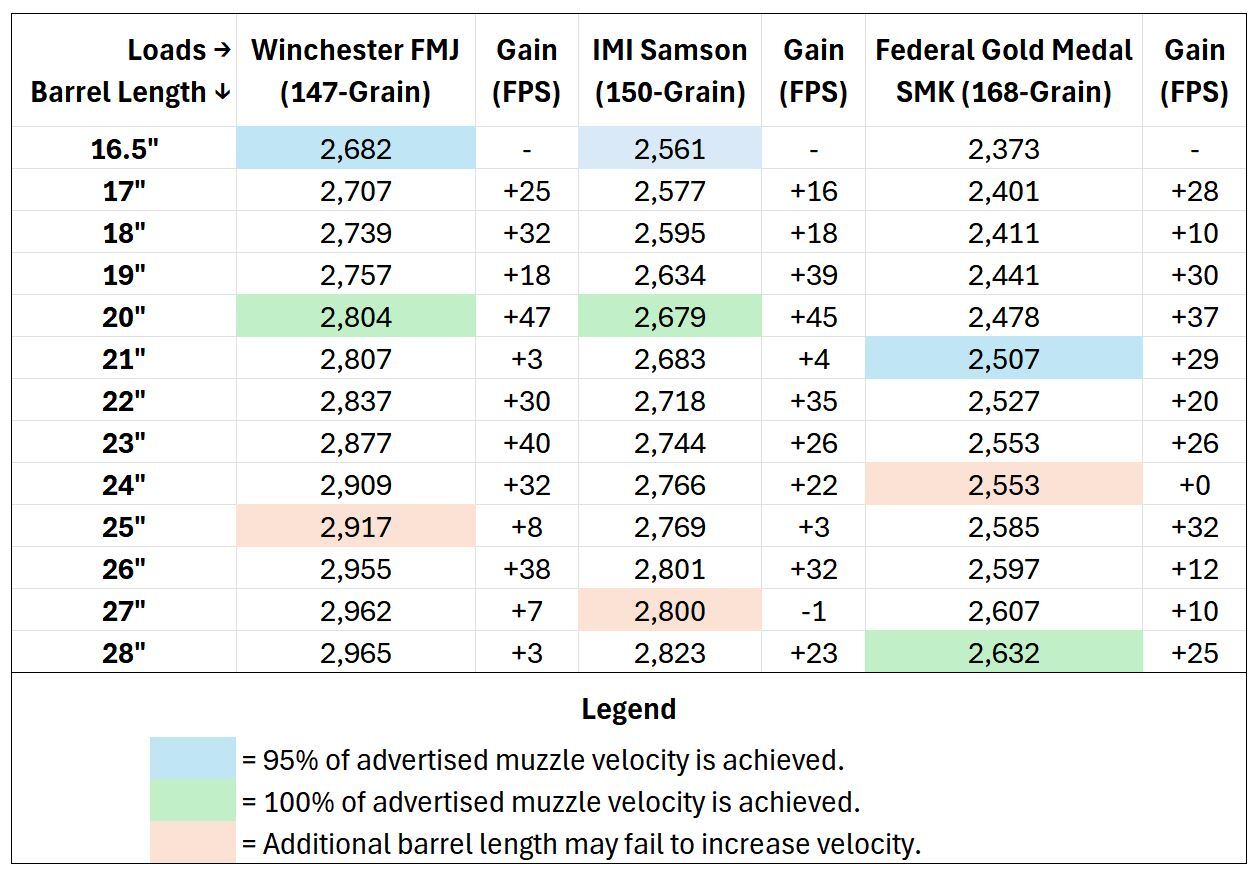What is The Best Barrel Length for .308? The Ballistic Data
Posted by Gunbuilders.com on Aug 15th 2025
Despite new long-range cartridges coming out yearly, .308 Winchester -- and its military equivalent, 7.62x51 NATO -- remains one of the most popular long-distance calibers today. That's largely thanks to the AR-10 and LR-308 platform.
This begs the question: What's the best barrel length for .308?
When chambering this cartridge in a tactical rifle like the AR-10, you need to compromise on barrel length to find a good balance of accuracy and weight. The .308 and 7.62x51 loads can achieve optimal performance with surprisingly short barrels.
Here's the ballistic data to prove it.
.308 Winchester: Barrel Length vs. Muzzle Velocity

For the data above, we've compared the muzzle velocities of .308 Winchester across three loads: 147-grain FMJ from Winchester, 150-grain FMJ from IMI Systems, and 168-grain Sierra MatchKings from Federal.
The muzzle velocities highlighted in green represent the barrel length at which that ammo's advertised muzzle velocity is achieved. The muzzle velocities highlighted in blue represent the barrel length at which 95% of the advertised velocity is achieved.
Lastly, the velocities highlighted in red represent the barrel length at which additional length may fail to increase muzzle velocity, given that ammo's standard deviation of average velocities. For example, the 147-grain Winchester ammo produced a standard deviation of plus or minus 20 FPS when fired from a 25" barrel.
With a 25" barrel, the measured increase in velocity compared to a 24" barrel was 8 FPS. But at this length, the muzzle velocity could, in fact, be 12 FPS less than when fired from a 24" barrel (subtract the 20 FPS deviation from the 8 FPS measured increase).
So, What's The Best Barrel Length For .308?
The .308 and 7.62x51 NATO rounds are used to fulfill different purposes, including hunting, tactical applications, and long-range target shooting. Different barrel lengths are optimal for each application.
A 16" barrel is ideal for hunting and tactical marksmanship.
With a 16" barrel common hunting and military rounds, including both Winchester FMJ and M2 Ball NATO ammo, achieve 95% of their advertised muzzle velocities.
- 147-Grain Winchester FMJ has an advertised muzzle velocity of 2,800 FPS. More than 95% of this velocity (2,660 FPS) is achieved with a 16" barrel.
- 150-grain IMI Samson FMJ has an advertised muzzle velocity of 2,680 FPS. More than 95% of this velocity (2,546 FPS) is achieved with a 16" barrel.
By achieving 95% of advertised velocities, the ballistic performance for either round between 100 and 500 yards is nearly identical to the performance achieved using a 20" barrel, which yields 100% of advertised velocities.
We can confirm this by looking at the differences in bullet drop, windage, and energy when a 147-grain load is fired from a 16" barrel (achieving 95% muzzle velocity) and a 20" barrel (achieving 100% muzzle velocity):

Note: Ballistic data is presented assuming a 10 MPH, 90-degree crosswind.
We can see that between 100 and 300 yards -- the distance at which most hunters take most deer with a rifle -- the 16" barrel allows 147-grain .308 to offer virtually identical performance compared to a 20" barrel, with just 1" to 2" of additional bullet drop, and no meaningful difference in windage observed at these distances.
At 500 to 800 yards -- the distance most often cited for tactical shooting and DMR (Designated Marksman Rifle) applications -- the 16" barrel yields just 10% more bullet drop while providing more than 90% of the energy produced by the 20" barrel. Even at 1,000 yards -- a figure most shooters agree is the maximum practical distance for .308 Winchester and 7.62x51 NATO, based on hit probability -- the 16" barrel suffers only 10% more bullet drop, 9% less energy, and 5% more wind drift.
A 20" barrel offers maximum performance for most loads and applications.
Most .308 and 7.62x51 NATO loads achieve their maximum advertised velocities with a 20" barrel. Beyond this barrel length, you'll only see marginal increases in velocity -- if at all. Because of the tendency for velocities to differ by as much as 20 to 30 FPS between every round fired, you may find that using a barrel longer than 20" may only yield single-digit gains in velocity.
With a 20" barrel, you'll achieve 99% or more of the ballistic performance .308 and 7.62x51 was made to provide, especially if you only chamber off-the-shelf FMJ ammo.
A 24" barrel is the maximum length for match-grade ammo and competitive shooting.
Only the heaviest match-grade loads, like 168-grain or heavier Sierra Matchkings, may benefit from using a barrel as long as 24". Even for these loads, choosing a longer barrel may yield zero additional gains in velocity, while adding unnecessary length and weight to your rifle.
(Your Barrel's Steel & Finish Matter, Too)
Barrel length is just one metrics when it comes to maximizing your rifle's performance. Want to obtain even better accuracy with the shortest possible barrel? Make sure you pick the right barrel steel and finish by reading these next:
- 416R Stainless vs. 4150 CMV: Which Barrel Steel's Better?
- QPQ Nitride vs. Chrome Lining: Which is The Better Barrel Finish?
DISCLAIMER: If you are new to the world of DIY gun building, you likely have a lot of questions and rightfully so. It’s an area that has a lot of questions that, without the correct answers, could have some serious implications. At GunBuilders.com, we are by no means providing this content on our website to serve as legal advice or legal counsel. We encourage each and every builder to perform their own research around their respective State laws as well as educating themselves on the Federal laws. When performing your own research, please be sure that you are getting your information from a reliable source.

